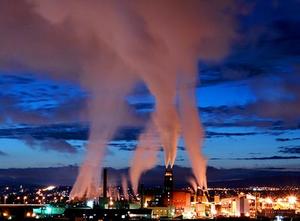Infrastructure protectionArtificial volcanoes to reverse global warming
British scientists are investigating a method to reverse the effects of climate change by creating an artificial volcano and suspending it 12.5 miles above the earth; the team’s goal is to recreate the cooling effect that a volcano has when it releases millions of tiny particles into the stratosphere that bounce some of the Sun’s rays back into space

Artificial volcano pollution generators // Source: wellsphere.com
British scientists are investigating a method to reverse the effects of climate change by creating an artificial volcano and suspending it 12.5 miles above the earth.
The team’s goal is to recreate the cooling effect that a volcano has when it releases millions of tiny particles into the stratosphere that bounce some of the Sun’s rays back into space. Scientists believe that they can simulate this by attaching a massive floating balloon to a hose and then pumping hundreds of tons of tiny chemical particles each day. The project is still in its research phase and the team is readying a scaled down version of the artificial volcano. With the help of a £1.6 million grant from the British government and the Royal Society, the team will first send a balloon more than half a mile into the air and pump water to see if their plan is even feasible. Eventually researchers hope to test the impact of spraying sulphates and other aerosol particles directly into the stratosphere.
The full-scale project presents several technical challenges including the control of a balloon the size of a football stadium at more than twice the cruising altitude of a commercial airliner.
The research team is comprised of scientists from Cambridge, Oxford, Reading, and Bristol universities, and is led by Matthew Watson, a Bristol University lecturer and a former U.K. government scientific adviser on emergencies.
Watson said the experiment is inspired by volcanoes and the way they can affect the climate after eruptions.
“We will test pure water only, in sufficient quantity to test the engineering,” he said.
Before the project can actually be deployed, Watson said that “much more research is required.”
Other proposals to create a similar cooling effect included using missiles, planes, and tall chimneys to send tons of particles into the air. In the end a balloon attached to a hose was the cheapest solution.
“The whole weight of this thing is going to be a few hundred tons. That’s the weight of several double-decker buses. So imagine how big a helium balloon do you need to hold several double-decker buses – a big balloon. We’re looking at a balloon which is possibly 100-200m (328 to 656 feet) in diameter. It’s about the same size as Wembley stadium,” explained Hugh Hunt, an engineering lecturer at Oxford.
“This hose would be just like a garden hose, 20km (12.5 miles) long and we pump stuff up the pipe. The nice thing about it is that we can really have a knob, if you like, which we can control to adjust the rate at which we inject these particles,” Hunt added.
The research project has generated criticism from environmental groups in Britain and the United States who say the experiment could have a dangerous effect on rainfall and food supplies. Critics also say that even if the balloon succeeds in cooling the atmosphere, it will do nothing to stop the build-up of carbon dioxide in the atmosphere, which leads to increasing ocean acidity.
“What is being floated is not only a hose but the whole idea of geo-engineering the planet. This is a huge waste of time and money and shows the U.K. government’s disregard for UN processes. It is the first step in readying the hardware to inject particles into the stratosphere. It has no other purpose and it should not be allowed to go ahead,” said Pat Mooney, the chair of ETC Group, an organization that supports socially responsible development of technology.
In defense of the project, Sir Martin Rees, the former president of Royal Society, said it was imperative for scientists to develop a “plan B” in the event that governments failed to reduce emissions.
“Nothing should divert us from the main priority of reducing global greenhouse gas emissions. But if such reductions achieve too little, too late, there will surely be pressure to consider a ‘plan B’ – to seek ways to counteract the climatic effects of greenhouse gas emissions by ‘geo-engineering’,” Rees said.
